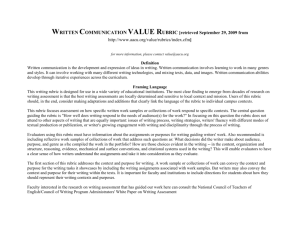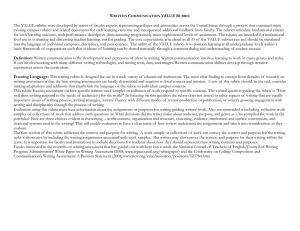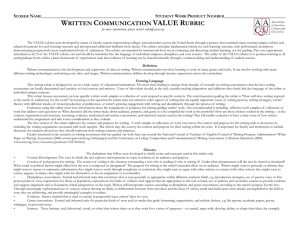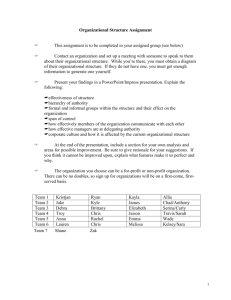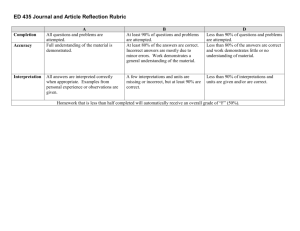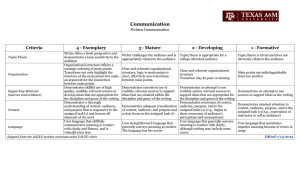VALUE Rubric- Written Communication
advertisement
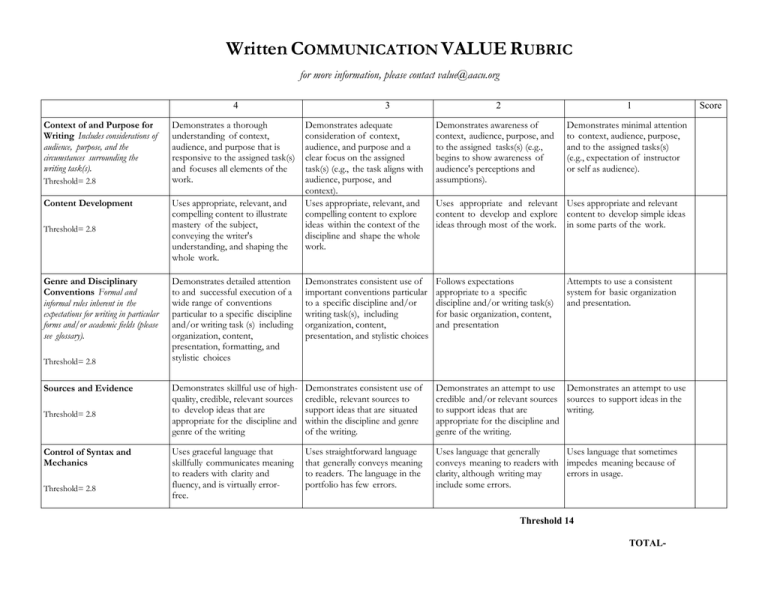
Written COMMUNICATION VALUE RUBRIC for more information, please contact value@aacu.org 4 Context of and Purpose for Writing Includes considerations of audience, purpose, and the circumstances surrounding the writing task(s). Threshold= 2.8 Content Development Threshold= 2.8 Genre and Disciplinary Conventions Formal and informal rules inherent in the expectations for writing in particular forms and/or academic fields (please see glossary). Threshold= 2.8 Sources and Evidence Threshold= 2.8 Control of Syntax and Mechanics Threshold= 2.8 Demonstrates a thorough understanding of context, audience, and purpose that is responsive to the assigned task(s) and focuses all elements of the work. 3 2 1 Demonstrates adequate consideration of context, audience, and purpose and a clear focus on the assigned task(s) (e.g., the task aligns with audience, purpose, and context). Uses appropriate, relevant, and compelling content to explore ideas within the context of the discipline and shape the whole work. Demonstrates awareness of context, audience, purpose, and to the assigned tasks(s) (e.g., begins to show awareness of audience's perceptions and assumptions). Demonstrates detailed attention to and successful execution of a wide range of conventions particular to a specific discipline and/or writing task (s) including organization, content, presentation, formatting, and stylistic choices Demonstrates consistent use of important conventions particular to a specific discipline and/or writing task(s), including organization, content, presentation, and stylistic choices Follows expectations appropriate to a specific discipline and/or writing task(s) for basic organization, content, and presentation Demonstrates skillful use of highquality, credible, relevant sources to develop ideas that are appropriate for the discipline and genre of the writing Demonstrates consistent use of credible, relevant sources to support ideas that are situated within the discipline and genre of the writing. Demonstrates an attempt to use Demonstrates an attempt to use credible and/or relevant sources sources to support ideas in the to support ideas that are writing. appropriate for the discipline and genre of the writing. Uses graceful language that skillfully communicates meaning to readers with clarity and fluency, and is virtually errorfree. Uses straightforward language that generally conveys meaning to readers. The language in the portfolio has few errors. Uses language that generally Uses language that sometimes conveys meaning to readers with impedes meaning because of clarity, although writing may errors in usage. include some errors. Uses appropriate, relevant, and compelling content to illustrate mastery of the subject, conveying the writer's understanding, and shaping the whole work. Demonstrates minimal attention to context, audience, purpose, and to the assigned tasks(s) (e.g., expectation of instructor or self as audience). Uses appropriate and relevant Uses appropriate and relevant content to develop and explore content to develop simple ideas ideas through most of the work. in some parts of the work. Attempts to use a consistent system for basic organization and presentation. Threshold 14 TOTAL- Score Definition Written communication is the development and expression of ideas in writing. Written communication involves learning to work in many genres and styles. It can involveworking with many different writing technologies, and mixing texts, data, and images. Written communication abilities develop through iterative experiences across the curriculum. Framing Language This writing rubric is designed for usein a widevarietyof educational institutions. The most clear finding to emergefrom decades of research on writing assessment is that the best writing assessments are locallydetermined and sensitive to local context and mission. Users of this rubric should, in the end, consider makingadaptations and additions that clearlylink the languageof the rubric to individual campus contexts. This rubric focuses assessment on howspecific written worksamples or collections of workrespond to specific contexts. The central question guiding the rubric is "How well does writing respond to the needs of audience(s)for the work?" In focusing on this question the rubric does not attend to other aspects of writing that are equallyimportant: issues of writing process, writing strategies, writers' fluency with different modes of textual production or publication, or writer's growingengagement with writing and disciplinaritythrough the process of writing. Evaluators using this rubric must haveinformation about the assignments or purposes for writing guiding writers' work. Also recommended is including reflective work samples of collections of workthat address such questions as: What decisions did the writer makeabout audience, purpose, and genreas s/he compiled the workin the portfolio? Howare those choices evident in the writing -- in the content, organization and structure, reasoning, evidence, mechanical and surface conventions, and citational systems used in the writing? This will enableevaluators to have a clear sense of howwriters understand the assignments and takeit into consideration as they evaluate The first section of this rubric addresses the context and purposefor writing. A worksample or collections of work can conveythe context and purposefor the writing tasks it showcases by including the writing assignments associated with worksamples. But writers mayalso conveythe context and purposefor their writing within the texts. It is important for facultyand institutions to includedirections for students about howtheyshould represent their writing contexts and purposes. Facultyinterested in the research on writing assessment that has guided our work here can consult the National Council of Teachers of English/Council of Writing Program Administrators' White Paper on Writing Assessment (2008; www.wpacouncil.org/whitepaper) and the Conference on College Composition and Communication's Writing Assessment: A Position Statement (2008; www.ncte.org/cccc/resources/positions/123784.htm) Glossary • • Content Development: The ways in which the text explores and represents its topic in relation to its audienceand purpose. Context of and purpose for writing: The context of writing is the situation surrounding a text: who is readingit? who is writing it? Under what circumstances will the text be shared or circulated? What social or political factors might affect howthe text is composed or interpreted? The purposefor writing is the writer's intended effect on an audience. Writers might want to persuade or inform; they might want to report or summarize information; they might want to workthrough complexityor confusion; they might want to arguewith other writers, or connect with other writers; they might want to conveyurgencyor amuse; they might write for themselves or for an assignment or to remember. • Disciplinaryconventions: Formal and informal rules that constitute what is seen generallyas appropriatewithin different academic fields, e.g. introductorystrategies, use of passivevoice or first person point of view, expectations for thesis or hypothesis, expectations for kinds of evidenceand support that are appropriateto the task at hand, use of primary and secondarysources to provide evidence and support arguments and to document critical perspectives on the topic. Writers will incorporate sources according to disciplinaryand genre conventions, according to the writer's purposefor the text. Through increasinglysophisticated use of sources, writers develop an ability to differentiate between their own ideas and the ideas of others, credit and build upon workalreadyaccomplished in the field or issue theyare addressing, and provide meaningful examples to readers. • Evidence: Source material that is used to extend, in purposeful ways, writers' ideas in a text. • Genre conventions: Formal and informal rules for particular kinds of texts and/or media that guideformatting, organization, and stylistic choices, e.g. lab reports, academic papers, poetry, webpages, or personal essays. • Sources: Texts (written, oral, behavioral, visual, or other) that writers drawon as they work for a varietyof purposes -- to extend, argue with, develop, define, or shape their ideas, for example.
